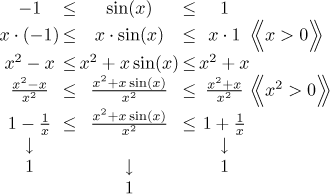Problem: Evaluate (if it exists) the limit
![]()
Solution:
This is a standard problem, we want to find a limit at infinity of an
expression that exists on a neighborhood of infinity (e.g. for
![]()
where N stands for a limit that does not exist. We can try to call on
the
algebra of N, but it does
not help us anyway, since it says that

Again we have an expression that cannot be handled using the limit algebra and the algebra of N. However, this time we get some help from boundedness, since there si a rule "bounded times zero is zero". Thus we get

Thus the limit that we obtained after the l'Hospital does not exist, which is rather bad; the l'Hospital rule states that the equality is valid only if the limit on the right exists. Here it does not, so the l'Hospital step was not justified and the given limit can be just anything. Obviously we need a different approach.
This problem does not exactly fit some standard box, but it is related somehow to the box "polynomials at infinity" and above all to the box "comparison and oscillation". When facing a non-typical problem, it is usually helpful to get some feeling for the behaviour of the given expression, which is where the intuitive evaluation comes in. What happens when x grows large?
The sine oscillates between −1 and 1, so the term
![]()
How do we prove such a guess? The intuitive evaluation approach calls for factoring out dominant terms. Here they are the same in the numerator and the denominator, so it is faster to just divide both parts by x2.
![]()
How did we know that the second term goes to zero? We used the rule "zero
times bounded is zero". What if this rule was not covered in your course, so
you are not allowed to use it? Or what if you do not trust it? A complete
proof can be done using methods from the box
"comparison and oscillation". We
have an oscillating part in the given expression and this part is bounded, so
it fits quite well. We claim that there is a proper limit, such claims are
usually done using the Squeeze theorem. We will show in detail how one can
derive an estimate for the given expression using a known bound and algebra.
Since we are interested in limit at infinity, we will do our estimates for
x large, in particular for

This concludes the problem, we proved that the given expression goes to 1 at infinity.
Remark: To get a better feeling for this behaviour, we will look at some modifications of this problem.
Problem:
![]()
The numerator is the same as above, so it behaves like x2, but this time the denominator is only x, so the fraction should go to infinity. Again, we can prove it by comparison, but since here we have an improper limit, we can try one-sided comparison since it is easier. We will need a lower estimate to push the given expression up.
![]()
Problem:
![]()
Now we have a different situation in the numerator. As we observed above, the
product
One possibility that works here is to divide and use the algebra of N.
![]()
However, since this algebra is usually not covered, we need a different
solution that would satisfy everybody. In the case of oscillation one would
typically use the
Heine theorem. In order to prove
that no limit exists we will construct two sequences,
First, define
Next we define
This proves that f cannot have a limit at infinity, since this limit would have to be equal to both 2 and 1, a contradiction.
Problem:
![]()
Now the numerator is the same as in the previous example, so it oscillates
between 0 and
![]()
If a more complete proof is needed, the easiest way out is the absolute value version of the Squeeze theorem.
![]()